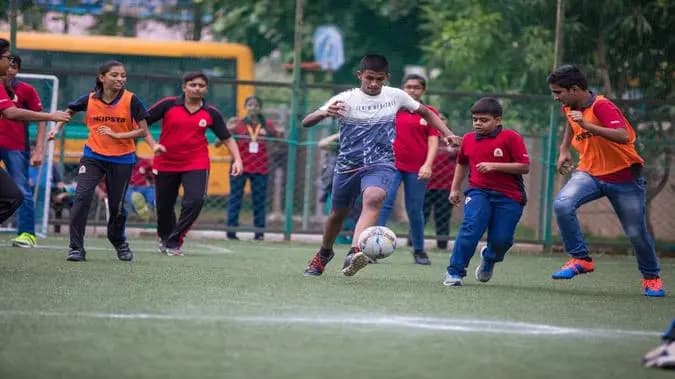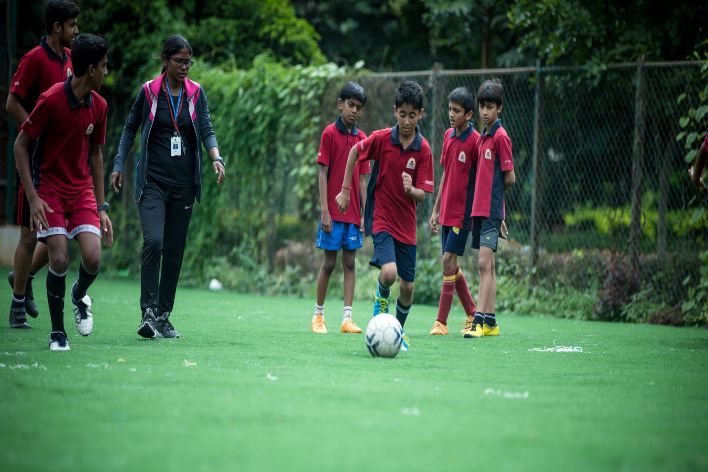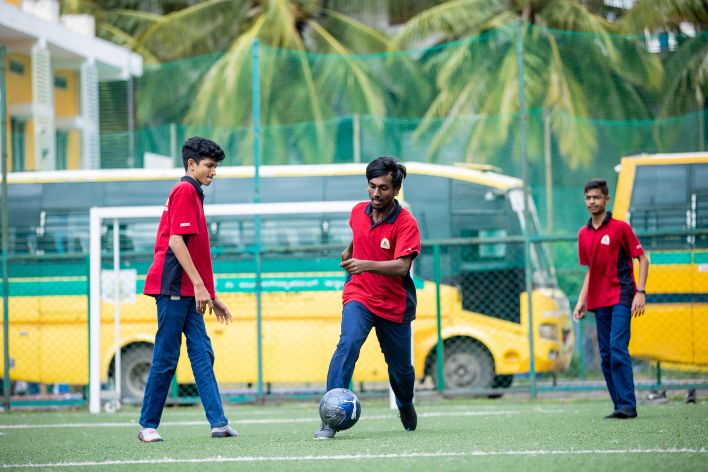Introduction to Football for Kids: A Comprehensive Guide
By Pinkey Sharma |
Date 07-08-2024

Table of Contents
- Benefits of Football to Kids
- Getting Kids Involved in Football: Tips to Get Started
- Football Games for Kids: Fun, Engaging Activities
- Football Coaching for Kids: Tips and Techniques
- Football Training for Kids: Development of Skills and Physical Fitness
- Football Shoes for Kids: How to Choose the Right Footwear
- Best Football Shoes for Kids: Top Picks and Recommendations
- Conclusion
- Frequently Asked Questions:
- Related blogs:
Admissions Open for
Football is a sport that has captivated millions of fans and players globally. To kids, football isn't just a game. It involves opening up to physical fitness, teamwork, and discipline—all in good fun, though. This comprehensive guide will go into everything parents and coaches need to know about introducing football to kids, from the benefits and basics to coaching tips, training routines, and equipment essentials, right down to the last detail.
Benefits of Football to Kids
Physical Fitness and Health
Association football is a physically demanding game that offers very good lessons for general fitness. It involves exercises that improve cardiovascular endurance, strengthens muscles, and helps the child to become agile and coordinated. The game will also ensure that they have a healthy weight, flexibility, and a boosted immune system if practiced frequently.
Social Skills and Teamwork
It's a team game where all the players have to work together in pursuit of a common objective. This develops some of the basic social skills in one, such as communication, cooperation, and compassion. Children will learn how to support their teammates, gracious defeat or victory, and develop lifelong friendships.
Discipline and Responsibility
Kids' football training involves regular training, following appropriate rules, and timely timing. As a result of these traits, kids who play develop a sense of discipline and are made responsible. Commitment and timing are instilled into them as they learn to take instructions.
Cognitive Development
Kids learn to strategize in football and make decisions very fast. They will have to prepare themselves for any situation ahead of their opponents, think within split seconds, which will help develop their cognitive skills, enhancing their problem-solving skills, stereoscopic thinking, etc.
Emotional Well-being
Playing football, in a way, allows the mind to relieve stress. This is an outlet for energy and emotion, hence reducing anxiety levels to a great extent, elevating one's mood. The accomplishment of completely new skills and winning serves as a booster for self-esteem and confidence.
Getting Kids Involved in Football: Tips to Get Started
When to Introduce
Children as young as three years can be introduced to football in a very friendly and informal way. At this age, only playful activities that involve kicking, running, and basic ball control should be emphasized. Then, with the growing age, structured training and games can be introduced.

Selecting the Right Football
When buying a ball for your kids to play football with, consider their age and skill level. Children under 8 years should use a size 3 ball, children from 8-12 years a size 4 ball, and children above the age of 12 years a size 5 ball. Go for one which is made of tough materials and suitable for outdoor plays.
Safety First
Safety first in any football introduction to kids—ensure playing areas are free from hazards, the kids wear appropriate gear including shin guards and football shoes for kids. Keep the children hydrated and always warm them up to avoid injuries.
Football Games for Kids: Fun, Engaging Activities
Dribbling Relays
Organize a dribbling relay race for the children to dribble the ball through several cones or markers. This would provide them with not only enhancement of their ball control but also of their coordination and speed. One can run this game as individuals or in a team competition to make it more interesting.
Passing Drills
Passing drills are very important to develop teamwork and accuracy. Design a passing circle where kids pass the ball to each other, calling out the name of the recipient. This drill improves communication and precision in passing.
Practice in Shooting
Set up a small goalpost and have the kids take turns to shoot at the goal. Mix up the distance and angle of shots to create a challenge for their shooting. Bring in some friendly competitions or introduce some targets within the goal to spice up the action.
Small-sided Games
Organize small-sided games with fewer players and smaller fields that offer more opportunities for each child to touch the ball, make decisions and score goals compared to full-scale matches, for which it becomes the opposite—intimidating. This helps build confidence.
Keep-away Games
Keep-away games allow one team to maintain possession of the ball while the other tries to steal it. The children learn very important skills in games that include ball control, shielding, and teamwork. These games are able to be designed for different levels of skill and with varying numbers of players.
Football Coaching for Kids: Tips and Techniques
Build a Positive Environment
A positive, encouraging environment is very essential for young players. Emphasize critical effort and improvement aside from winning. Praise achievement, give constructive feedback, and create a supportive atmosphere where children feel valued and motivated.
Focus on Fundamentals
Focus on the basics: dribbling, passing, shooting, and defending. Provide children with a good foundation in fundamentals before expecting advanced techniques. Make sure to include learning with fun through proper age-compatible drills and activities.
Motivate Creativity
Though structure is important, allowing kids to express their creativity on the field is equally essential. Allow them to try different moves and take risks to develop their own playing style. It instills a love for the game and develops well-rounded players.
Teach Teamwork
Football game is a team game, and the value of teamwork is something they have to learn. Plan activities that involve cooperation, problem-solving, and communication. Help them respect each other's ability and build on others' strengths as well as supporting them; develop common goals.
Keep it Fun
Most importantly, football must be fun for the kids. It should include games, challenges, and many different types of activities so that their interest will not dwindle. The amount of pressure involved should not be too great, and fun and learning should be balanced.
Football Training for Kids: Development of Skills and Physical Fitness
Warm-up and Stretching
Any training should be started with a proper warm-up and stretch. This is due to the fact that it prepares the muscles for action and prevents them from possible injuries. Dynamic stretches, jogs, and some light exercises will give you a good rise in blood flow.
Dribbling Skills
Dribbling is among the most basic developed skills in football. Organize several drills that bear on the different aspects of dribbling, speed, control, and change of direction. Make challenging courses using cones, markers, or any other obstacle the kids are expected to dribble through.
Passing and Receiving
Passing and Receiving Drills: Passing and receiving drills should form the central part of football training for kids. Teach them different types of passes, such as short passes, long passes, and through balls, insisting on accuracy, timing, and positioning.
Shooting and Finishing
Ball-shooting techniques into the goal: It involves techniques of exposing children to varied ways of shooting, for instance, volley, header, and ground shots. Get them to shoot on certain targets to get experience with accuracy.
Defensive skills
Defending is an important aspect of low-level football. Teach girls basics of marking, tackling, and intercepting. Use drills imitating game scenarios for one-on-one challenges with a defending team and small-sided defensive scenarios.
Fitness and Conditioning
Add some fitness and conditioning exercises to the training regime that will improve the overall physical performance of a player. Put another way, develop endurance, strength, agility, and speed. Include activities such as sprints, circuit training, and plyometrics to make it fun for kids.

Football Shoes for Kids: How to Choose the Right Footwear
Why Kids Need the Right Football Shoes
Proper football shoes are important for both the safety and performance of a player. It provides one with the right kind of traction, support, and protection on various surfaces. If shoes are ill-fitting or not appropriate, they may cause discomfort and lead to an increased potential of getting hurt.
Types of Football Shoes
There are different types of football shoes for different surfaces played on. These include firm ground shoes designed for natural grass, artificial ground shoes for artificial turfs, indoor shoes for indoor courts, and soft ground shoes for wet or muddy conditions.
Factors to Consider
Factors to consider in choosing football shoes for children include fit, comfort, and durability. The shoes should neither be too tight nor too loose, having maximum comfort allowing the natural movement of the feet. Materials making up the shoes are also essential, looking for those capable of handling regular gameplay.
Recommended Football Shoes for Kids
-
Adidas Predator Mutator 20.1: This model provides great grip on firm ground, so is good for kids who play their football on these surfaces.
-
Nike Jr. Mercurial Vapor 13: These lightweight shoes are great for giving great speed and traction to the ball when kicked. It's sort of like an extra kick, really aiding young players in the game.
-
PUMA Future 6.4: These comfortable shoes with fair support are perfect for kids to play on artificial grass or indoor courts.
Best Football Shoes for Kids: Top Picks and Recommendations
Choosing the Best Football Criteria
Factors to consider when selecting a ball for kids include size, material used in the making, and durability. Size should be according to the age and skill level of the child. High-quality materials ensure that the ball will last for a good duration since it will be used regularly.
Recommended Footballs for Kids
-
Adidas Starlancer V: This ball happens to be one of the most specifically great footballs for kids. It is robust with good construction only ideal for the youngest players. The sizes it comes in accommodate all age groups.
-
Nike Pitch Team Soccer Ball: This ball is convenient for practice sessions and games due to the durability and consistency it provides. Kids who play soccer frequently will love how the PUMA Future Flare Ball has an outlandish design with great build quality.
Conclusion
Football for kids is much more than a game; rather, it is a potentially enriching activity in the fields of physical, social, and cognitive development. From the time they are first acquainted with the game to advanced training and coaching, each phase is vital in the development of interest in football among young players. Parents and coaches should therefore pay great attention to fun, safety, and how skills are developed so that children reap colossal benefits from football.
Be it through engaging football games for kids or structured football coaching for kids, everything is towards the development and enjoyment of the children. The right equipment, therefore—like suitable football shoes for kids and the best football for kids—only adds to that experience and performance on the field.
This means creating a positive and enriching environment for children to participate, learn from, and subsequently develop a lifelong passion toward the game of football. In doing so, we would not only be raising better football players but also better human beings equipped with the skills and values that will benefit them both on and off the pitch.
Frequently Asked Questions:
What is the introduction of football?
Football is a globally popular team sport where two teams of eleven players each aim to score goals by getting a ball into the opposing team's net using any part of their body except their hands and arms.
What is football in simple words?
Football is a game where two teams try to score goals by kicking a ball into the opposing team's goal.
How to explain football in simple terms?
Football is a sport where players run, pass, and kick a ball to score goals while following specific rules.
How to write 10 lines about football?
-
Football is a team sport played by two teams of eleven players.
-
The objective is to score goals by getting the ball into the opposing team's net.
-
Players can use any part of their body except their hands and arms.
-
The game is played on a rectangular field with a goal at each end.
-
Matches are typically divided into two halves of 45 minutes each.
-
Football is governed by a set of rules known as the Laws of the Game.
-
It is the most popular sport in the world, with millions of fans and players.
-
Major football tournaments include the FIFA World Cup and UEFA Champions League.
-
Football promotes physical fitness, teamwork, and strategic thinking.
-
The game is known for its passionate fans and vibrant cultures around the globe.
Related blogs:
Holistic Benefits of playing Football: Discover how football boosts kids' health, social skills, and well-being beyond the game.
Mental Skill in Football: Boost your football performance with key mental skills: focus, strategy, and resilience!
CBSE Schools In Popular Cities
- CBSE Schools in Bangalore
- CBSE Schools in Mumbai
- CBSE Schools in Pune
- CBSE Schools in Hyderabad
- CBSE Schools in Chennai
- CBSE Schools in Gurgaon
- CBSE Schools in Kolkata
- CBSE Schools in Indore
- CBSE Schools in Sonipat
- CBSE Schools in Delhi
- CBSE Schools in Rohtak
- CBSE Schools in Bhopal
- CBSE Schools in Aurangabad
- CBSE Schools in Jabalpur
- CBSE Schools in Jaipur
- CBSE Schools in Jodhpur
- CBSE Schools in Nagpur
- CBSE Schools in Ahmednagar
- CBSE School In Tumkur

Call Us to know more about Orchids
Swipe Up
















